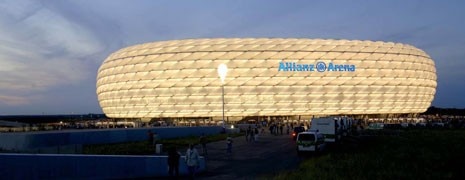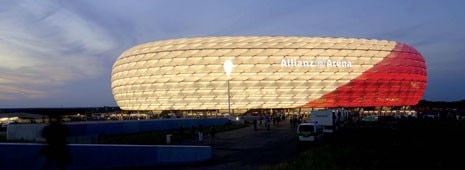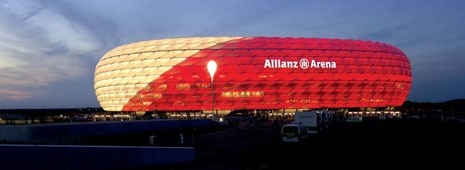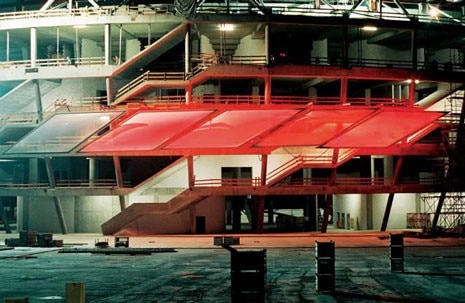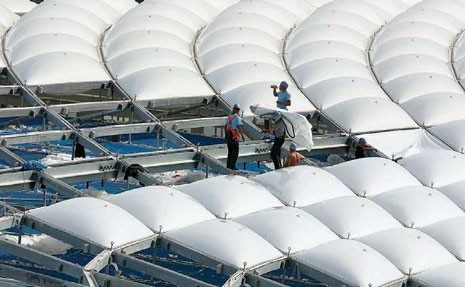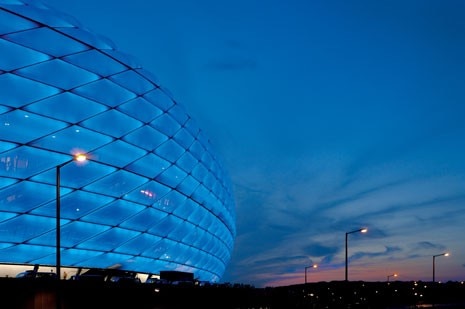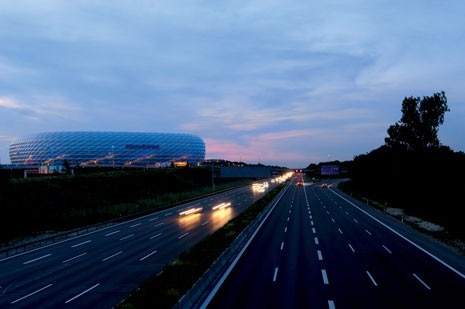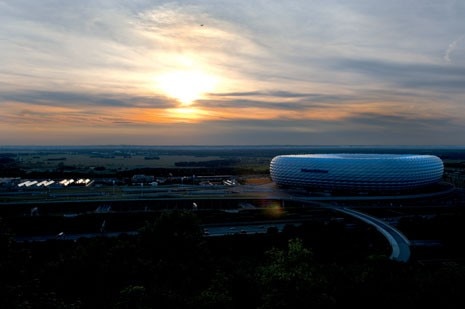The city-stadium
Rowan Moore
From 1972, when Frei Otto designed his Olympic Stadium in Munich, to the forthcoming Wembley Stadium by Norman Foster and HOK, convention has dictated that the biggest task in designing a sports stadium is holding up the roof. This is achieved with tensile structures, wires strung from arches or masts, or with trusses as big as road bridges. Analogies are made, ever more wearily, between the straining structures and the sinews of athletes. At the same time stadiums have become more complex as regards their role.
They are not just places to watch sport, but small cities made up of restaurants, shops, conference facilities and elaborate amenities for sponsors and the media, which means that holding up the roof becomes an ever less central part of the project. Perhaps for this reason, few of Otto’s followers have achieved the simple beauty of his design, which lay in its recapturing of the Greek idea that a sports arena should be little more than a place set within the landscape. The point of his roof was the tent-like lightness with which it lay on the landscape. Herzog & de Meuron’s Allianz Arena, also in Munich, makes all of the large roof stadiums since Otto look old-fashioned.
It is a cultural artefact, not a work of engineering, whose inspiration was not a suspension bridge but a collaged image of footballers performing in a baroque theatre. Its first concern is to create as close a relationship as possible between players and spectators in a space the architects compare to both a “crater” and Shakespeare’s Globe Theatre. This space is a room, not a piece of equipment. Its qualities are determined by the steep slope of the seats, the sense of continuity between the lower and upper parts, the slight curve in the rows of seats to give a greater sense of enclosure, and the veiling of the structure behind a translucent skin of ETFE.
When the stadium is full during a match, the architecture recedes, present only in its contribution to the intensity of the experience. On the outside the building tries to make sense of its peripheral location, defined by a large road, grassed-over refuse heaps and distant views of the city. At one level the arena is a piece of roadside architecture, a big squashed football that functions like the doughnut-shaped doughnut shops in Los Angeles that once delighted Charles Jencks, albeit in a less literal, more sublimated way. Like the doughnut buildings it has an ambiguous scale: you know it is big, but it also looks like something you could put in your pocket or maybe even eat. As in almost all of Herzog & de Meuron’s projects, games are played with your perception.
The Allianz Arena, wrapped in ETFE cushions, turns the heavy concrete reality of the building’s construction into something apparently weightless and almost portable, transforming 1960s thinking about inflatable structures into a poetic myth. This skin also enables the stadium’s most eye-catching effect: its ability to change colour. By day it gives off a pearly white iPod glow, like a desirable consumer object. By night it lights up red, white or blue, depending on the team playing. The ground is shared by Bayern Munich, who play in red, and the blue-clad TSV Munich 1860 club. The German national team (in white) will also play here. The cladding represents an idea of transience, not its reality, but the design also works more directly with movement and change.
The architecture is completed by the event, by the crowds approaching and filling it. The fans arrival over the convex roof of the car park, by way of a scrubby landscape that deliberately echoes the surrounding wastelands, is subtly choreographed by the architecture. The convex curve means that the Arena slowly rises into view as it is approached; the planting creates a sense of walking through a big field. The Arena is a work for a less innocent age than Otto’s monument to social democratic, internationalist enlightenment. It represents an era where funding comes entirely from private finance and sponsorship, where the sponsor’s logo becomes an integral part of the design and the architecture, and where the image of the building both before and after construction is a crucial consideration.
The design includes the Business Club, a corporate hospitality space whose ceiling is clad in anodised aluminium cylinders. Close-packed and porous, they look like a sponge in spite of their hardness. The Club is a prime example of what should be called Taschenspace, in which, like the famous publisher’s books, 1970s decadence is evoked to create an ironic, faintly lubricious aura. This is not to say that Munich’s new stadium is better or worse than the old one. The Allianz Arena speaks eloquently to its own culture, in which the powerful physical reality of a football match can evanesce through marketing and the media into a weightless image, and in which the tribal, geographically rooted loyalties of supporters can be translated into coloured lighting effects. This bubble-wrapped concrete crater plays beautifully from one to the other, from the visceral acoustic of the crowd’s roar to the blur of light on the skyline.
